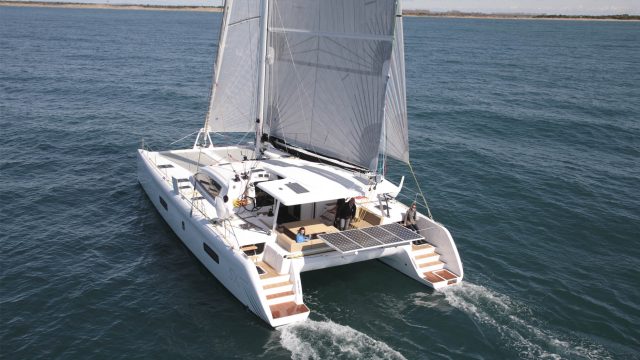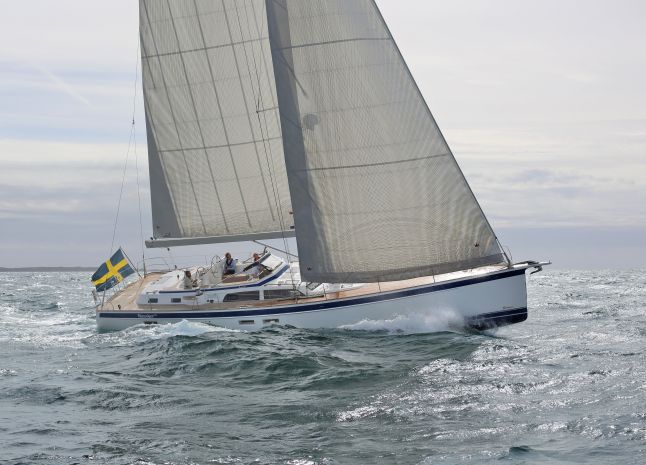
Sailing across the Atlantic is more than just an item on a bucket list for sailors. It’s how you get your boat to new horizons, whether to cruise the Caribbean islands or explore the waters around Europe. It’s a big undertaking and requires serious planning and a solid sailing vessel. You can cross the Atlantic by yourself, with a rally of like-minded racers and cruisers, or as part of a highly competitive race. But no matter how you go, the choice of a good sailing yacht lies at the foundation of a safe and enjoyable crossing.
Recap of the best yachts for a transatlantic
| Yacht | Type | Main Highlights for a transatlantic |
|---|---|---|
| NEEL 51 | Trimaran | Fast and comfortable, suitable for smaller crews, easy handling, double-digit speeds, spacious design. |
| Outremer 5X | Catamaran | High-speed performance, multiple helm stations, designed for small crews, comfortable with ample space. |
| Hallberg-Rassy 57 | Monohull | Sturdy construction, elegant design, capable of 200-mile days, generous accommodations for gear. |
Our selection of ideal yachts for a transatlantic crossing



There are many yachts which are suitable for a transatlantic passage. Some will be less expensive, some will be more comfortable, faster, or better suited to you, your experience, and your budget.
NEEL 51: Fast and easy to sail trimaran
The NEEL 51 is a fast, comfortable trimaran suited to a smaller crew. It’s spacious, but easy to handle while putting up double digit speeds and 200+ mile days. Trimarans can be a little more sea-kindly in waves and chop than catamarans, and don’t heel hard like monohulls. A protected helm station gives great protection offshore and good visibility, and there space on board for plenty of crew and guests.
The racing version of the NEEL 51 is built with lighter materials, and features a larger rig to project more sail area for more speed, while still affording the same luxury and comfort at anchor.
More info about our Neel 51 available for charter
Outremer 5X: High-speed catamaran sailing
The Outremer 5X offers top tier performance and comfort in a single passage. Sustaining double digit speeds with east, the Outremer 5X is one of the fastest cruising catamarans on the market. Outremer is known for both performance and quality, and your transatlantic trip will be fast and safe.
With four different helm stations, she’s a sailing boat foremost. It’s designed for a small crew, even when tearing up the ocean on a fast passage. With options for three or four cabins and a cockpit that can fit a dozen people, she’ll be as comfortable when you arrive as she is fast on passage.
Hallberg-Rassy 57: Sturdy monohull with elegance and speed
Hallberg-Rassy builds tough cruising yachts, and the 57 is no exception. While monohulls don’t put up the blistering speeds you’ll find in multihulls, the Hallberg-Rassy 57 is no slouch and can log 200 mile days. Most offshore sailing and cruising is done in monohulls, and blue water sailors love their stability and seakindliness across all conditions.
The Hallberg-Rassy 57 has generous accommodations, and loads of capacity for gear supplies. The deck layout is clear, and lines and controls are laid out for easy use with a small crew. With a performance design by German Frers, the 57 sails well on all points of sail.
What does a boat need for a transatlantic crossing?
If you choose to do your transatlantic crossing with a rally or race, you’ll have to meet a stringent list of required equipment and safety checks. That’s easier because you have the lists right in front of you, and a team of inspectors to check your work. Preparing for a crossing with just one boat, the captain has to take all the responsibility and know what to check.
Sailing across the Atlantic is a serious undertaking, and you will sail out of range of shore-based rescue and into rapidly changing and possibly severe weather systems. You will have several thousand miles of nonstop sailing and may be at sea for several weeks.
What you must have
Any boat sailing across the Atlantic needs solid construction and a sound rig, a reliable auxiliary engine, and enough stores for food and water for the crew. That’s a bare minimum. Every boat needs to be checked from stem to stern to make sure systems are reliable, many older boats can certainly make this trip, and not every new boat is suitable.
Some tiny boats have crossed the Atlantic, so minimum size isn’t a requirement. What successful boats have in common is a solid hull and rig, with reliable sails and systems.
Most transatlantic yachts have a lot more
You can cross the oceans with a lightly equipped boat with few conveniences or extra safety gear, but most do not. A few things to look for on your boat include:
- An EPIRB satellite rescue beacon.
- Long range communication devices, such as satellite phones and single sideband radios.
- Certified life raft with space for all crew on board.
- Storm sails
- Storm safety gear such as drogues or sea anchors.
- Access to up-to-date weather forecasts and reports.
Do not head offshore without these
The list of required equipment for races and rallies is exhaustive, and many of the requirements are exacting and expensive. No one is enforcing compliance when you sail on your own. But there are a few things you should not head offshore without.
- A reliable auxiliary engine. If the wind dies and you need to dodge bad weather, this can be a lifesaver.
- Access to good, current weather information.
- Reliable sails. Have all sails inspected by a sailmaker for wear and damage before setting out.
- A life raft. If you run into serious problems and lose your boat, this is your last hope for rescue.
- Spare parts and tools for common repairs.
Read also: 10 Sailing Myths And Bad Advice You Shouldn’t Listen To
What experience do you need to do a transatlantic?
A transatlantic crossing is a major sailing milestone for experienced sailors. The north Atlantic is no place for new sailors and beginners, unless they’re with competent and experienced crew or a qualified captain.
If you’re thinking of a transatlantic crossing on your own, you’ll need experience with multi-day, nonstop passages. Sailing offshore is twenty-four hours a day and nonstop, there’s no place to park. Experience with night sailing, standing watches, navigation, provisioning, and basic engine and system troubleshooting are all a must.
Read also: Five Easy Beginners-Friendly Sailing Trips And Destinations
Chartering a yacht – a great option for less experienced sailors.
Charter fleets make seasonal moves from Europe to the Caribbean are an excellent way to get offshore sailing experience. Charter companies provide a captain and first mate, but you can reserve a spot and fill the roles of a full crew member, standing watch and sailing far offshore.
Many boats are also available for charter in cruising rallies, races, and deliveries. You’ll need to hire a captain with the needed offshore experience, but you may come away with enough experience to skipper your own yacht the next time.
Conclusion
There are many choices for the best boat for you for a transatlantic crossing. No matter which boat you choose for your transatlantic and how you go – on your own, or on a charter – preparation is key. Your boat needs to be equipped with a full range of safety gear, and checked from top to bottom so you know your sails, hull, and engines will get you where you’re going.
Read also: The Caribbean To Mediterranean Sailing Routes: How To Cross The Atlantic Eastward

